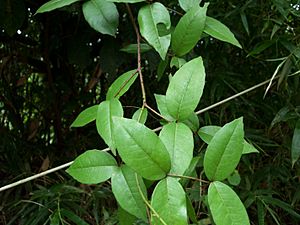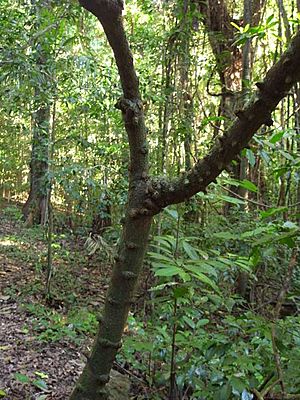Shiny-leaf prickly-ash facts for kids
Quick facts for kids Shiny-leaf prickly-ash |
|
|---|---|
 |
|
| Scientific classification | |
| Genus: |
Zanthoxylum
|
| Species: |
nitidum
|
| Synonyms | |
|
|
The Shiny-leaf prickly-ash (scientific name: Zanthoxylum nitidum) is a cool plant known by different names. In Assamese, people call it tez-mui. In China, it's known as liang mian zhen. This plant is a type of flowering plant in the Rutaceae family, which also includes citrus fruits like oranges and lemons!
It's a woody climber, meaning it's a plant that grows like a vine, with a strong, wood-like stem. It has sharp prickles on its younger branches. Older parts of the plant, like the main trunk, have thick, cone-shaped spines. Its leaves are special because they are "pinnate." This means they have smaller leaflets arranged along a central stem, much like a feather. Each leaf usually has five to nine of these small leaflets.
The plant also produces flowers that are white or pale yellow. These flowers grow in groups called "panicles" or "racemes" at the ends of branches or where leaves meet the stem. The flowers can be either male or female. After flowering, it produces small, round, red or brown fruits.
What it Looks Like
The Shiny-leaf prickly-ash is a woody plant that climbs. It has curved prickles on its younger branches. Its main trunk and older branches have thick, cone-shaped spines.
Its leaves are long, usually about 10 to 34 centimeters (4 to 13 inches) in length. Each leaf has five to nine smaller leaflets. These leaflets are shaped like an egg or an oval. They are about 4.5 to 10 centimeters (1.8 to 4 inches) long and 2 to 5 centimeters (0.8 to 2 inches) wide. Some leaflets attach directly to the main leaf stem, while others have a tiny stalk.
The flowers grow in clusters up to 8 centimeters (3 inches) long. Each tiny flower sits on a small stalk. They have four small green parts called sepals, which are like tiny leaves at the base of the flower. They also have four white or pale yellow petals, which are the colorful parts of the flower. These petals are about 2 to 3 millimeters long.
Some flowers are male and have four stamens, which are the parts that make pollen. These male flowers also have four small, finger-like parts that don't develop into fruit. Other flowers are female and have four carpels, which are the parts that will become the fruit. Female flowers do not have stamens.
This plant usually flowers from September to October. Its fruit is a round, red or brown follicle, which is a type of dry fruit. Each fruit is about 5 to 7 millimeters long.
How it Got its Name
The Shiny-leaf prickly-ash was first officially described in 1824. A scientist named William Roxburgh gave it the name Fagara nitida. He wrote about it in his book, Flora Indica, or, descriptions of Indian plants.
Later in the same year, another scientist, de Candolle, changed its name to Zanthoxylum nitidum. He did this in his own book, Prodromus Systematis Naturalis Regni Vegetabilis. This is how the plant got its current scientific name.
Where it Grows
You can find the Shiny-leaf prickly-ash in many places around the world. It grows in India, South China, and other parts of Southeast Asia. It also grows in northern Australia.
In Australia, it likes to grow in rainforests. You can find it from sea level up to about 400 meters (1,300 feet) high. It grows from the Daintree River area south to Rockingham Bay.
Uses and Safety
In some places like India and Nepal, the fruits of Zanthoxylum nitidum are used as a condiment. This means they are used to add flavor to food, much like a spice.
However, it's very important to know that the roots, leaves, and fruit of this plant are poisonous. Even a small amount of the leaves can be very dangerous if eaten. So, it's not a plant to touch or taste without knowing exactly what you are doing and with adult supervision.
This plant is also one of several Zanthoxylum species used in traditional medicine in different parts of the world. People have used it for a long time for various health purposes, based on traditional knowledge.
Plant Chemicals
The Shiny-leaf prickly-ash contains special chemical compounds. Some of these are called nitidine, toddalolactone, and chelerythrine.
The essential oil from some types of this plant also contains chemicals like limonene and geraniol. These are often found in plants and give them their scent.


